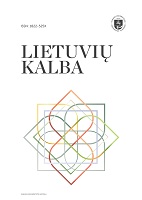BŪDVARDŽIŲ KIRČIAVIMO POLINKIAI XX A. 6–7 DEŠIMTMEČIO VAKARŲ AUKŠTAIČIŲ KAUNIŠKIŲ ŠNEKTŲ RANKRAŠTINIUOSE ŠALTINIUOSE
TENDENCIES OF THE ACCENTUATION OF ADJECTIVES IN THE WRITTEN SOURCES OF THE 1950S AND 1960S IN THE WEST AUKŠTAITIANS OF KAUNAS
Author(s): Vilija RagaišienėSubject(s): Phonetics / Phonology, Sociolinguistics, Baltic Languages
Published by: Vilniaus Universiteto Leidykla
Keywords: Lithuanian language; accentuation; adjectives; mid 20th century; West Aukštaitians of Kaunas;
Summary/Abstract: The article analyses the dialectal material collected in the area of the West Aukštaitian of the Kaunas subdialect in the written sources of the 1950s and 1960s at the Dialect Archive of the Geolinguistic Centre of the Institute of the Lithuanian Language. Based on the data in written sources the goal is to describe the peculiarities of the accentuation of the West Aukštaitian adjectives of this period and to discuss the tendencies of their accentuation. The stress of the singular forms of the disyllabic u-stem adjectives of the masculine gender may have come down from old times. Maintaining the root accent of these forms is related to the forms the neuter gender of the stressed stem (suñku, šviẽsu) and the adjectives of the old o-stem (suñkas : suñkus). The pronunciation of polysyllabic adjectives in the West Aukštaitian subdialect of Kaunas is characterized by different accent tendencies. The accentuation of the derivatives with the suffix -inis, -ė varies most of the polysyllabic adjectives analysed in the article. More than a third of them are accented by two accentual paradigms – they have accentual parallel forms of the first and second accent paradigms. The accentuation of the derivatives with the suffixes -inis, -ė is only partly related to the accentuation of the root words. The accentuation of the adjectives discussed in the researched subdialects tends to be generalized by the second accent paradigm. The derivatives with the suffixes -ėtas, -a regardless of the accentuation of the root words, are usually accented by the second accent paradigm, cf. molétas, -a (: mólis 1), pūslétas, -a (: pūslẽ 4). Only the accent of the derivatives with the suffixes -uotas, -a can be linked to the accentuation status of the root words, cf. langúotas, -a (: lángas 3). The author of the article is of the opinion that the accentual variance of parallel derivatives with suffixes could have been determined not by one factor, but by a set of factors. The appearance of accentual variants is linked to semantics, the accentual and semantic model of two plurals and the accentual variance of the root words and is explained by the stress analogy of the same type of word formation.
Journal: Lietuvių kalba
- Issue Year: 2020
- Issue No: 14
- Page Range: 1-18
- Page Count: 18
- Language: Lithuanian

